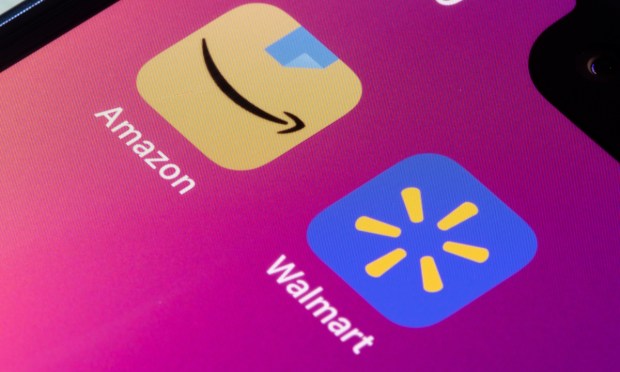Walmart Counters Amazon’s eCommerce Lead With Omnichannel Tech

As Walmart looks to shrink Amazon’s growing lead in consumer retail spending, the mega-retailer is turning to new technologies to merge the digital and physical shopping journeys to provide a more frictionless customer experience.
This week, the chain kicked off a range of technology efforts that bring digital convenience into the brick-and-mortar experience and bring in-person-like immersion to eCommerce platforms. For instance, the retailer has begun testing digital labels that light up to help shoppers navigate their way through its vast stores, according to a recent report. By activating these labels through an app, customers can easily locate the products they are looking for.
These digital labels are already being used by Walmart workers in some locations, flashing green to guide shelf stockers and blinking blue to assist product pickers in assembling eCommerce purchases. Now, a pilot of such technologies to help consumers in stores is reportedly on its way later this year.
Additionally, the retail giant announced Wednesday (Jan. 31) that it plans to build, convert or remodel 150 stores over the next five years, part of its “Store of the Future” concept, which incorporates interactive technology that blends online and in-person shopping.
The retailer is also looking to improve the digital purchasing experience by making it feel more like physical shopping, gearing up to enable consumers to virtually try on over 750 pairs of eyeglasses, gaining a realistic preview of how the glasses will appear on them, using augmented reality (AR).
These moves come as competitor Amazon is growing its lead in retail, according to the November edition of PYMNTS Intelligence’s Whole Paycheck Report, “Amazon Extends Its Lead Over Walmart in Retail Spend.”
The study, which drew on each of the company’s earnings reports in conjunction with national data from the U.S. Census Bureau and Bureau of Economic Analysis, showed that, as of Q3, the eCommerce giant held an 8.2% share of consumer retail spending, up from 7.6% the previous quarter. Meanwhile, Walmart’s share held flat quarter over quarter at 7.2%.
Amazon, for its part, has been racing to merge the digital and physical shopping experiences, with technologies such as its “Just Walk Out” computer vision checkout capabilities, which gather insights on consumers’ in-store habits much the way a merchant is able to track consumers’ behavior on eCommerce platforms. The retailer also has its Dash Cart smart shopping cart technology, which similarly brings digital checkout into the brick-and-mortar shopping experience.
Yet this past week, Amazon’s updates were more focused on pure-play eCommerce innovation.
The eCommerce behemoth expanded the availability of “Consult-a-Friend,” its mobile shopping feature that is designed to add a social and collaborative element to shopping on the platform, to all customers in the United States, Australia, Belgium, France, Germany, India, Italy, Mexico, Netherlands, Poland, Spain, Saudi Arabia, Singapore, Sweden, Turkey, the United Arab Emirates (UAE) and the United Kingdom, the company said Tuesday (Jan. 30).
“Customers look to a variety of sources when making purchasing decisions, and recommendations from friends and family are often among the most trusted sources,” Oliver Messenger, director of Amazon Shopping, said in a company blog post.
Also on Tuesday, the company touted improvements in its delivery times fulfilling digital orders from Prime Members.
Read more: Consumers Bought Over 500 Million Items From Amazon Third-Party Sellers in 2023
eCommerce is where Amazon’s lead is the most pronounced. According to data from the Whole Paycheck report, Amazon holds a 53% share of total eCommerce retail spending in the United States, while Walmart’s share comes in at under 7%.
As these retail giants compete for consumers’ spending, both digital and physical channels are key battlegrounds.
Findings from PYMNTS Intelligence’s study “Consumer Interest in an Everyday App,” which drew on insights from a survey of more than 3,300 consumers in the United States and Australia, revealed that, of the 61% of consumers who had shopped for a non-grocery retail product in the previous month, 72% did so via connected device at least some of the time. Plus, 61% did so via traditional channels at least some of the time.
Yet consumers are also interested in experiences that merge the digital and physical, such as Walmart’s AR try-on capabilities. For instance, the PYMNTS Intelligence study “How We Will Pay Report: How Connected Devices Enable Multitasking Among Digital-First Consumers” found that among the 95% of consumers who own or have in their home at least one internet-connected device, 39% would be interested in using a mobile app to see how a piece of clothing would look before buying it. Plus, 5% already do this.
As the competition between Walmart and Amazon intensifies, the integration of technology into the shopping experience will continue to be a key battleground. Both companies are striving to meet the evolving needs and preferences of consumers who are increasingly utilizing both digital and traditional channels for their shopping needs.
For all PYMNTS retail coverage, subscribe to the daily Retail Newsletter.

